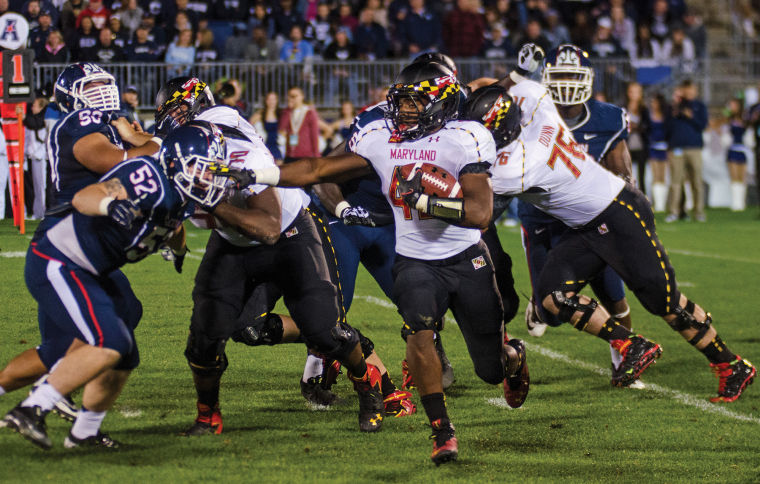
Running back Brandon Ross rushes during the Terps’ 32-21 win over the Huskies on Sept. 14, 2013.
Moving past a 63-point loss isn’t easy, but the Terrapins football team has a chance to return to form tomorrow against a shaky Virginia team that fell to Ball State, 48-27, last week.
Though the Cavaliers aren’t nearly as talented as Florida State, the Terps will still need efficiency in several areas if they hope to avoid another loss. Here are three keys to the game.
1) RUNNING GAME
We don’t know who will be under center for the Terps on Saturday with starting quarterback C.J. Brown listed as doubtful for the game with a concussion. But whether it’s Brown or backup Caleb Rowe taking snaps, the Terps are going to need more production from their running game.
The Terps rushed for 33 yards on 25 carries in last week’s 63-0 loss to the Seminoles, amounting to a putrid 1.3 yards per carry average. The offensive line failed to get any leverage, the quarterbacks weren’t making the right reads, and the backs weren’t hitting the holes hard.
The Seminoles could focus on stopping the pass once Rowe took over after Brown’s injury in the second quarter, and play-action fakes were rendered useless without production from the backs. The offense never got into a rhythm.
This week will have to be different if the Terps hope to move the football and score points.
“We’ve got to block people better, and we’ve got to maintain blocks. When you’re in the zone-read scheme, you’ve got to make sure you read it correctly,” offensive coordinator Mike Locksley said. “We’ve got to get all those things accomplished running the football, and we haven’t been very good at it.”
There is hope that the Terps can establish a running game Saturday, though. Ball State tailback Jahwan Edwards rushed for 155 yards and three touchdowns on 24 carries against Virginia last week, and Terps running back Brandon Ross could use a big game like that after totaling minus-1 yard in Tallahassee, Fla.
It will be especially crucial for the Terps to take advantage of the Cavaliers’ susceptibility to the run if Rowe is forced to start. If the Cavaliers put extra defenders in the box to stop the run, the sophomore will have an easier time making reads down the field.
Either way, the offense needs to be more efficient than it was against Florida State to give the Terps a chance.
“All those things are correctable,” Locksley said, “whether it’s through a change of personnel or guys getting better at the techniques and reworking some of the technical things that it takes.”
2) PASS RUSH
The Terps haven’t had much trouble getting to the quarterback this season, recording 18 sacks over the first five games.
Last week, though, the Terps had trouble bringing down Seminoles quarterback Jameis Winston when they did reach him. And the big, nimble redshirt freshman threw for 393 yards to make the Terps pay for sacking him just once during the rout.
The Terps face another dual-threat signal-caller in Virginia’s David Watford on Saturday.
“The quarterback’s a good runner,” defensive coordinator Brian Stewart said. “He does a good job of reading. They’ve got a zone-read scheme that they run and he’s not a bad passer. He’s got a good, strong arm. He’s a good athlete.”
The combination of Watford’s arm and legs could be lethal, especially against a Terps team playing without its two starting corners and outside linebacker Matt Robinson — who has been key in covering tight ends and running backs — because of injuries.
So to take pressure off the coverage units, the Terps need to make Watford get rid of the ball quickly.
3) FORCE TURNOVERS
The ability to force turnovers — specifically interceptions — was crucial to the Terps’ four-game win streak to open the season.
In their 47-10 blowout of Old Dominion, the Terps picked off Taylor Heinicke three times to thwart a talented Monarchs attack. A week later, the Terps needed a pair of Dexter McDougle interceptions to escape Connecticut with a 32-21 win. Then, against West Virginia, an A.J. Hendy pick-six — the second of six Mountaineers turnovers — strengthened the Terps’ 37-0 blowout win.
Against Florida State, however, the Terps didn’t force a single turnover. And while doing so may not have made a big difference in the 63-0 debacle, it could have at least curbed the Seminoles’ momentum a bit.
Stewart runs an aggressive, attacking defense designed to put players in position to make big plays like sacks and interceptions. If the Terps can’t make those plays, the aggressiveness can backfire, leaving the defense vulnerable, like it did against Winston and Florida State.
But with an antsy home crowd likely to be behind the Terps on Saturday, one key play could really get the team rolling. Turnovers helped the Terps get the season off to a hot start; now they need them to get the campaign moving back in the right direction.



